In previous parts of this feature we have been introduced to the life of a Scottish transport company, providing haulage services to a small community of people living on the Scottish Western Isles. After being introduced to the company profile and everyday operations, we have accompanied a driver on his journey from Glasgow to port of Uig on the top of Isle of Skye, from where he took a ferry to Lochmaddy on North Uist. We left him when he was preparing to sleep when after disembarking delayed ferry found an overnight parking spot on the beach. Today we’ll see how the most important part of his journey looks like. That is: delivering across sparsely populated isles lost somewhere on the Atlantic.
How to get one’s own satellite.
Cry of seabirds and first rays of the rising sun penetrating the curtains woke us up. We had a really good sleep, so we quickly get up from bed. Morning brushing of our teeth is made easier by the jaw drop caused by seeing, where we just spend our night. Clouds coloured by the morning sun are reflecting in the thin layer of water covering the beach. If not for hundreds of mounds left by some creatures and out tracks from last night, one could have a feeling of standing at the edge of a giant mirror.
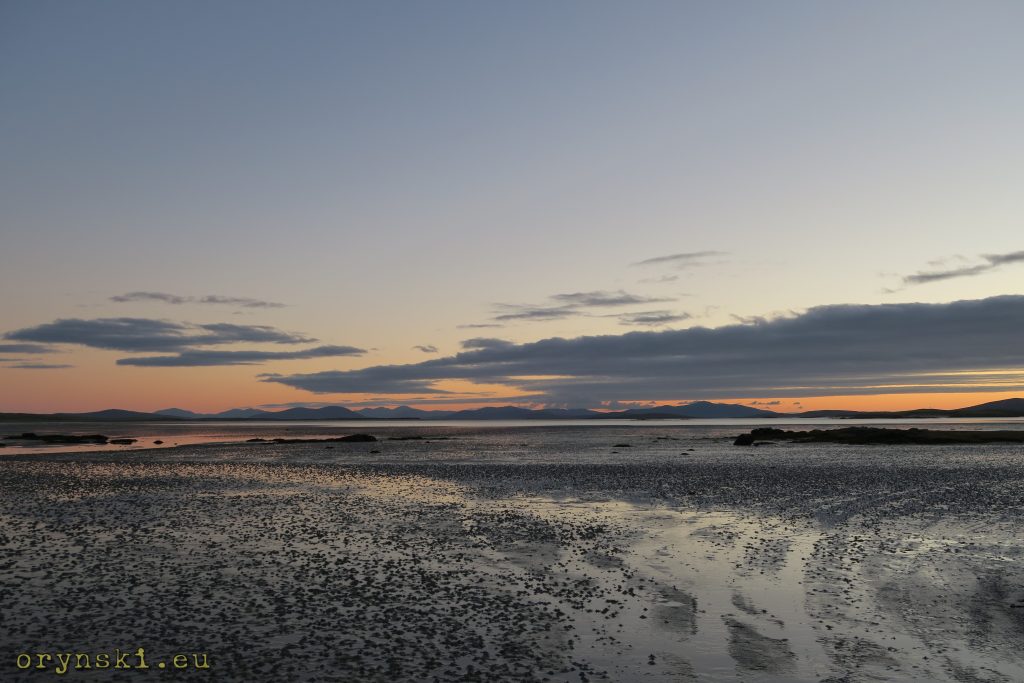
But we are here not to enjoy the panorama. Taking advantage of two bars of network coverage we call Calum. But we don’t want to book a night in his B&B – his other job is to help us out with our deliveries. We set a meeting point to port in Lochmaddy.
It takes slightly more than 10 minutes to get back there, but it proves to be a challenge: the sun is just over the horizon and nor the sunglasses, nor the sunshades over the windscreen are able to give us any help. But the views of the landscape flooded with early morning orange lights is compensates for all inconvieniences.
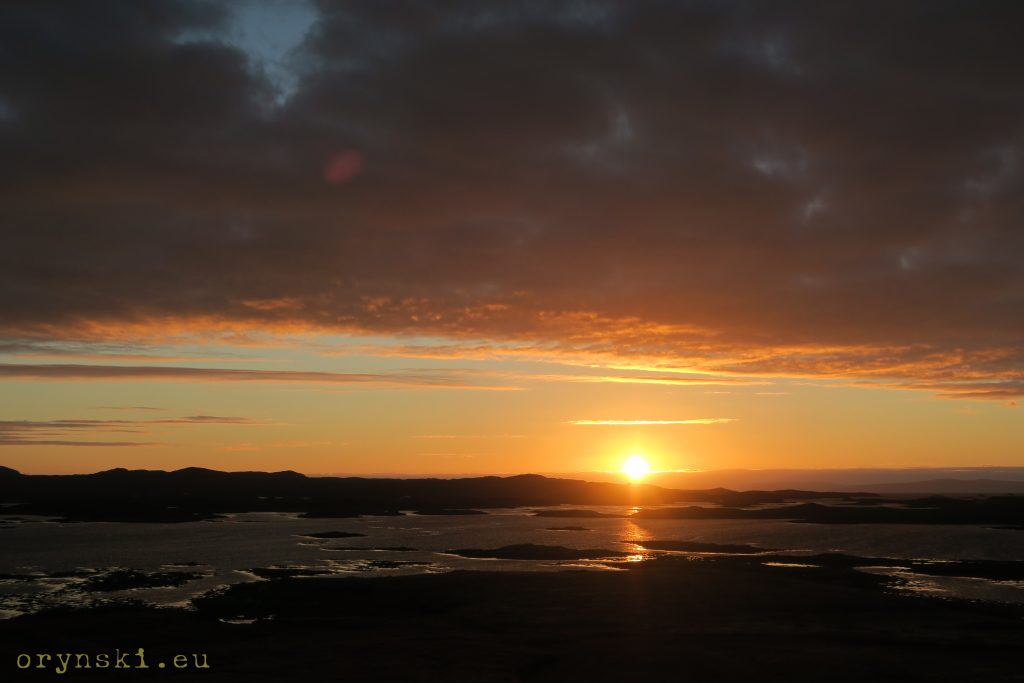
Finally, here we are. Calum is already here as well with his van. His job is to become our satellite for a day, as while our lorry might seem at first glance to be loaded in very chaotic way, in fact it is well prepared to being unloaded efficiently in right order. After short welcome we pull out the file marked “North Uist”, agree on the plan of action and then divide the load amongst us. Then we park our vehicles rear to rear and get to work: pallets and bigger loads mostly stay on the truck, most of the smaller items are being transferred to Calum’s van. While we will just travel directly from one place of bigger delivery to another, he will play Postman Pat, turning in every second small lane to deliver parcels to people’s houses accompanied by his plush Paddington Bear.
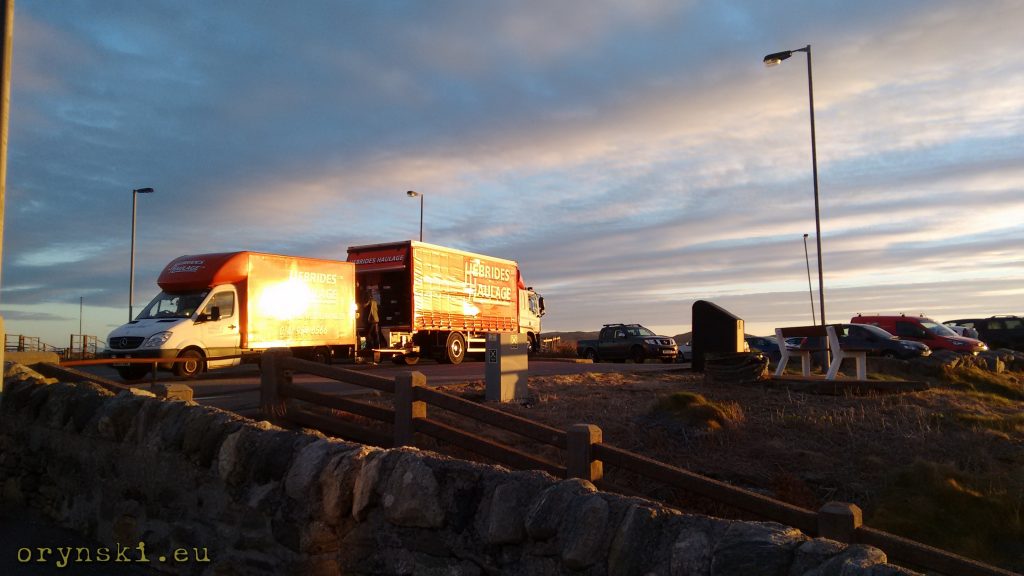
We set the next meeting point just after the causeway connecting North Uist with next island in order – Benbecula. As Calum has much more to do than us – today we only do a couple of drops on North Uist while he has to go pretty much everywhere – there is a time for morning tea. But the few cafes around here would not be open yet even during tourist season, but luckily for us we have our storm kettle with us. So a piece of paper, few sticks gathered around car park and 3 minutes later we pour a boiling water over our mugs. Storm kettle is an invention from this part of the world, and proves that, as it often is, the simplest solutions are often the best ones. Everyone who ever tried to use gas cooker in windy condition is familiar with difficulties it creates: you need to protect it from the wind, and even then the fire is likely to be extinguished. For storm kettle more windy the better, as the flow of air only instigates the fire to such extend, that it often shoots up the chimney like if it was some kind of the rocket engine – hence the alternative name, rocket kettle.
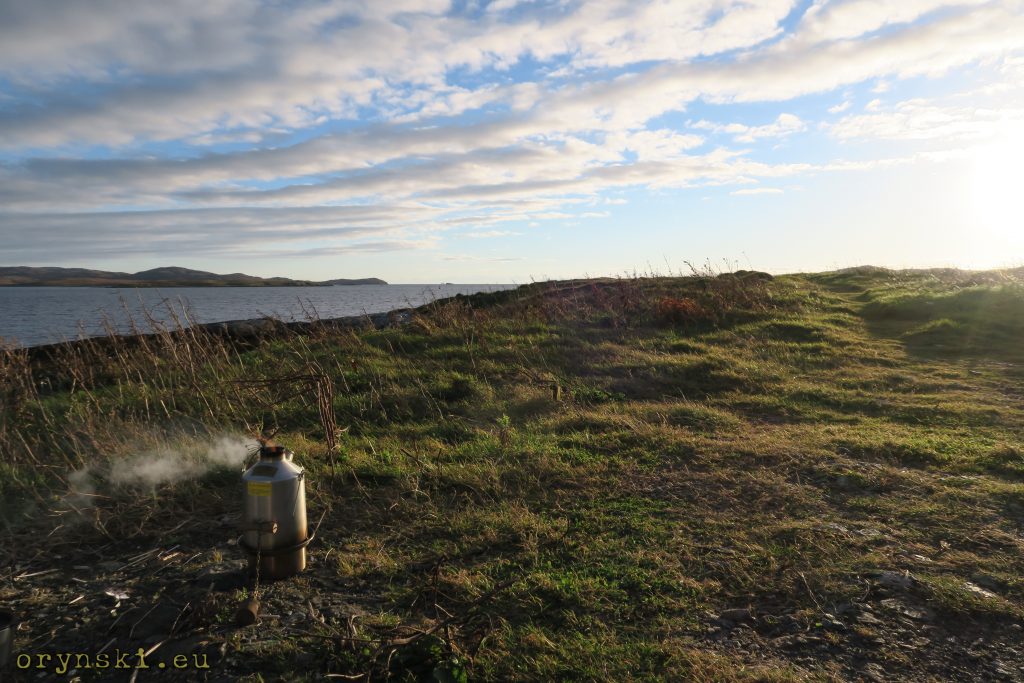
Driving on even the main island road would be a completely different experience for an average lorry driver. The narrow stripe of tarmac seems to be consisting mostly of narrow bends and bumpy mounds. Luckily, the local drivers have much friendlier approach to lorries than those on the mainland, therefore instead of moaning about “those bloody truckers getting in the way” they are doing everything to make our live easier. The common sense has a priority over the written highway code, so sometimes we pass the oncoming vehicles on the left, and sometimes on the right, as they give us way by pulling to either side, whichever would be more convenient for us for the moment.
The roadworks can cause bigger difficulties, as due to road being wide only enough for one vehicle at the time, the rules and regulations as per traffic cones and other signage not always provide for such situation. So the local road workers place them as they would do on the normal road to make Health and Safety guy happy, but then the problems are solved on the go using common sense, as you could see on this movie.
Outer Hebrides, when it comes to urban development, at first can seem really chaotic. History and present mixes up everywhere, it is nothing unusual to see a modern building designed by a posh architect across the road from traditional, thatched blackhouse.
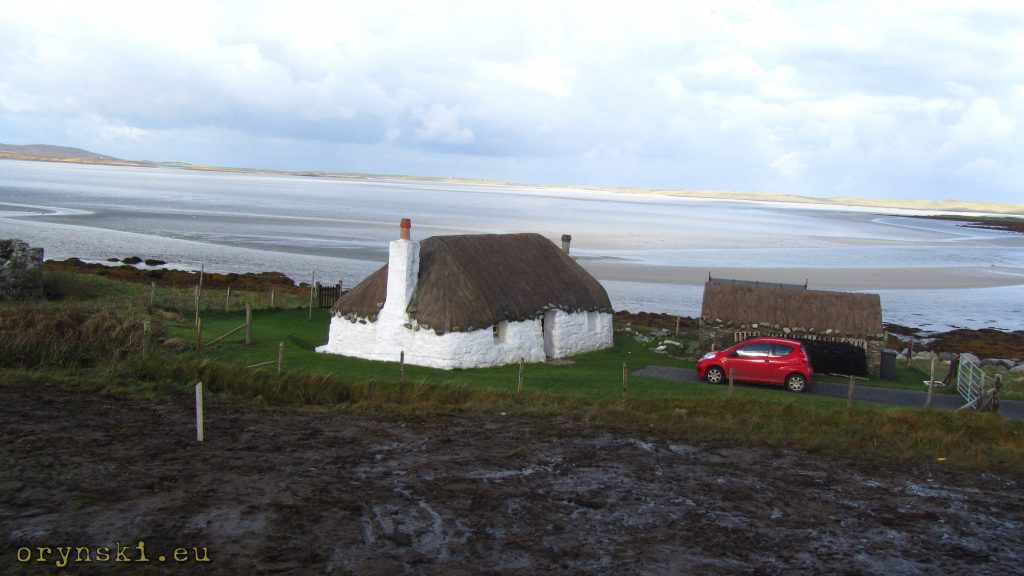
Serching for some urban plan would also come to no avail. Everything has to be set along the lines designed by the nature, as every immersion of the land becomes either a small pond or a boggy turf field, so the only places where construction is possible are the rocky hills scattered here and there. This has its advantages, for example that houses are sparsely scattered and rarely tall, so you can be pretty sure to have a beautiful view from pretty much every window of every house. And often that view will open to one of the most beautiful places in the whole world.

But we have not much time for contemplating the landscape. After delivering few boxes to the local shop/post office/gas station/solid fuel yard, we move to drop about twenty car tires to the local garage/engineering company/tool shop (yes, pretty much everyone on the island has many jobs). Then a swift u-turn, and we head to Benbecula to meet our satellite, who just arrived at the old fish processing factory just across the causeway. The causeway, that was widened recently, which propably made many locals happy, but nowadays it lacks that unique feeling you had when you were crossing the sea on the narrow stripe of tarmac while having nothing but the water up to the horizon on both sides…
In a busy metropolis.
During our next meeting with Calum we encounter a slight problem: some of the pallets in the middle of the lorry, where loads for Benbecula are placed, are doublestacked. Luckily, biggest settlement here, Balivanich, is, in local terms, a busy metropoplis. There is an airport, and some shops and garages, two supermarkets, small hospital, army base and a small industrial estate. Surely there will be a plece where we will be able to use a forklift! Therefore we decide to jump behind the wheels and soon arrive to the Balivanich City Centre, where on the small yard just next to the beach a rusty forklift is parked. Keys are in the ignition, so we are getting busy in no time and after transfering some of the small parcels to Calum’s van, we can finally spread pallets evenly over the back half of the lorry platform. At some moment the owner of the forklift arrives, but he is no angry at us – everyone here is used to help each other. He just came to check if we have a parcel that he was waiting for for several days already.
And so, after some castling we are ready to go again. For me, visit to Balivanich means dropping off majority of my loads, as the biggest companies on the islands are mostly located here. While I am getting busy dropping pallets in and around Balivanich, Calum’s van can be seen circulating around with smaller boxes between the surgery, army base, garage, school, local council and a few private houses.
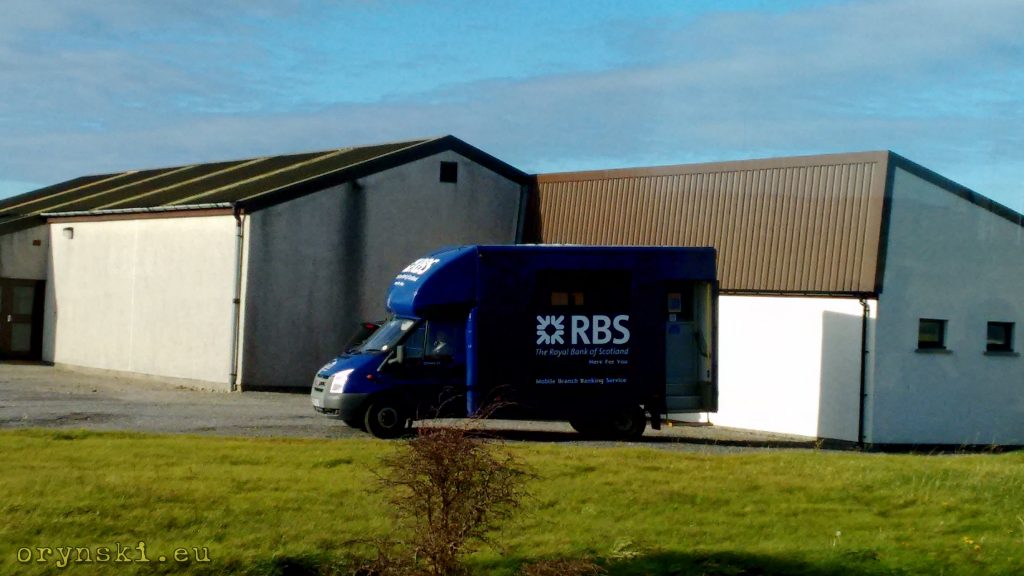
Islanders are lucky, as not only parcels, but also services are delivered almost to their doorsteps. Apart from delivery vans, mobile librares, banks, shops and dentist surgeries wander the island roads. Few times a year the islands are even visited by a mobile cinema smartly designed on the back of the articulated truck. Heated movie hall allows for up to 40 minutes to watch a movie in a good quality with Dolby Surround (although rain and wind bashing on the sides of the lorry can add some deepness to the movie’s soundscape during the quieter fragments).
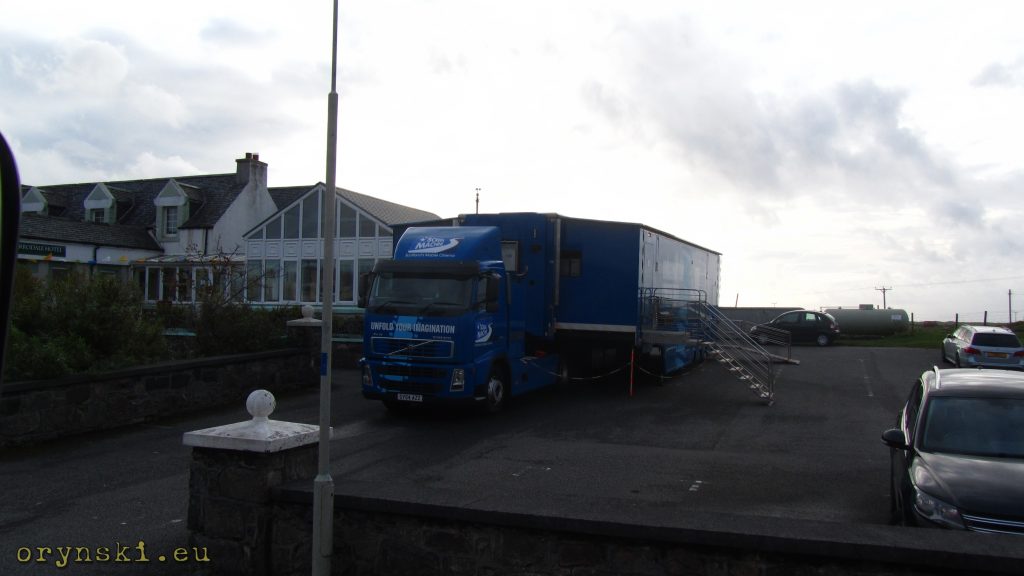
But while it’s cool sometimes to go to the cinema, life of Hebridean trucker is not short from other attractions. If you thought that narrow tarmac roads are the worst that he has to encounter, you have to know, that it is nothing unusual to deliver to houses that are built several hundred meters away from the nearest road. It requires driving on the narrow gravel path to the yard, that rarely allows for a 10 metre lorry to make a youturn, therefore one need to be confident to drive on the narrow track full of potholes with inches to spare on each side both in forward and reverse. How silly now it looks that challenge dreaded by all Polish learner drivers that required them to reverse along the bend build from the rubber traffic cones on a huge car park!
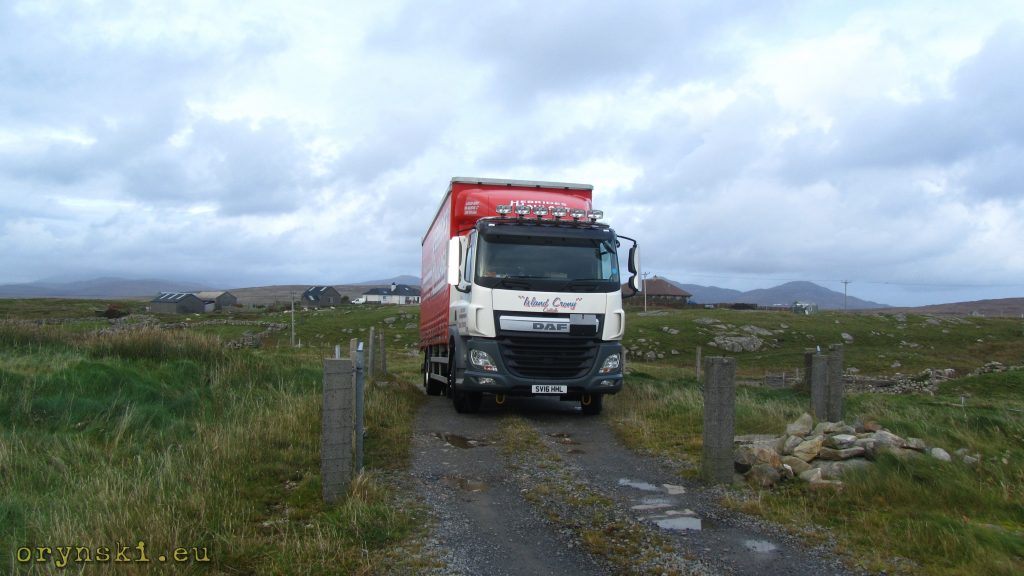
But there is also a chance to spread one’s wings – a wide road on which most of the drivers travel with motorway speed (have I mentioned already that on the islands common sense is prevailing over the letter of the highway code?). Next encounter with our satellite is set on the car park outside the shop just after yet another causeway – this time we are on South Uist. Here Calum takes over most of remaining parcels and a sofa set, so we are left with only three more deliveries to do. But it does not mean an easy day, as one of them takes almost 1/3 of the lorry: today, we are doing a removal as well.
First though, we have to visit the last link on this chain of the islands connected by causeways: Eriskay. The causwey, that has been build in 2001 is build in a standard, that would put many motorway lanes in shame, but bot approaches to it are rather closed to Hebridean standard, and in some places lorry can barely fit on the tarmac. But the beauty of place compensates for all difficulties, it is a real pleasure to go to Eriskay:
After we crossed the causeway, a white van blocks our way. Is that a robbery? Or perhaps even here a self-appoitment traffic policeman wants to tell us off for not looking at our speedo? Nah, it’s just yet another proof of how well the grapevine mail works here. Our next customer heard somewhere that the orange lorry is heading this way, and as the rumour was that it is not been driven by it’s usual driver, he decided to come and meet us, as it is not easy to find his place. But for yet another time, the views during delivery makes up for all the troubles.
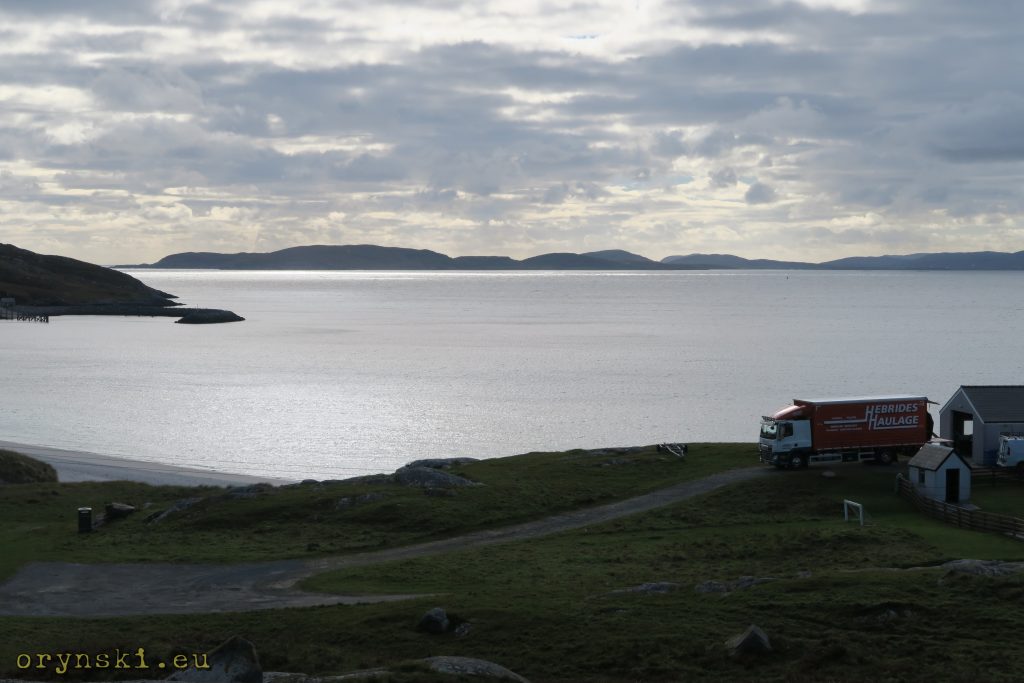
During our drive back towards the turquose sea we got a message to collect a washing mashine from a local shop. Calum has decided that there is no point for him to drive such a long distance (from islander’s perspective a 15 minutes drive is almost like exotic expedition). The problem is that he has a paperwork for it. But for the ladies in the shop it’s not the problem, everyone knows Calum here, so they can trust him to sort the paperwork later.
Hebrides are actually one of the last places in Europe where people trust each other. There is no need to close your doors or lock your cars. So after loading that washing machine that was returned by a customer, we are heading back to South Uist. By a coincidence we meet Calum’s van right at the junction for our final destination this day. Since it is a removal, Calum is joined by a mate, Donald. After all, doing removals can be hard graft. Our destination turns to be a small house in the middle of nowhere. The problem is that the road next to it is very narrow and a drive way is framed with a concrete walls. Everyone present assumes that it will be impossible to get a lorry there, but that only touches that string present in every Polish soul: “You say I won’t make it? JUST WATCH ME!”. After over a dozen shunts, the lorry is positioned perfectly to be unloaded, leaving just enough space on the main road to allow a school bus to pass.
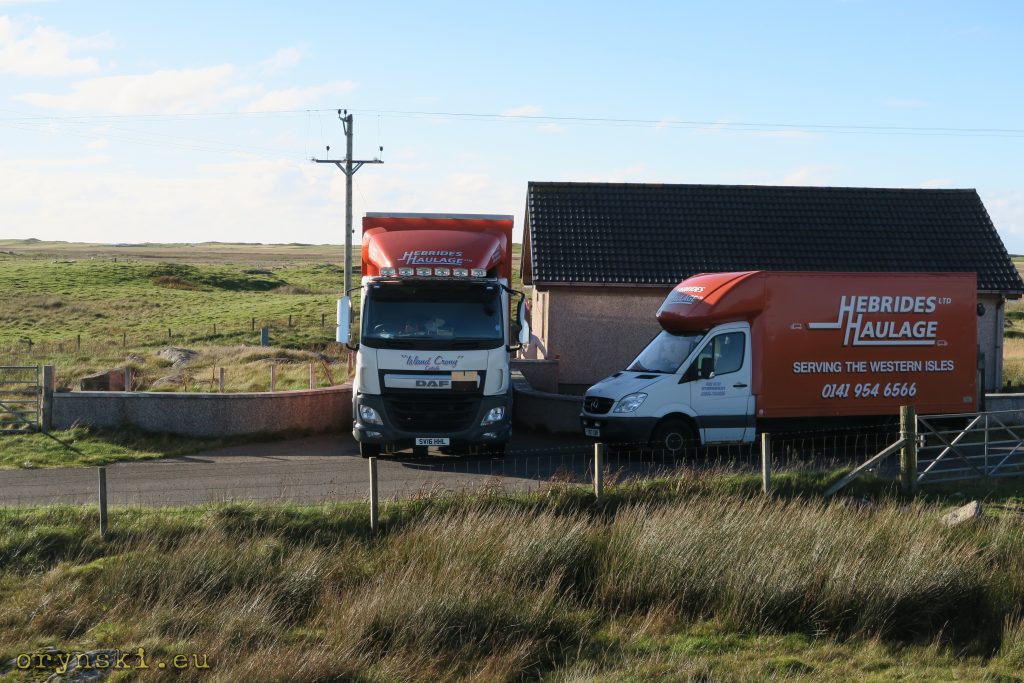
It turns out that we are going to be provided with much more than just Donald’s assistance. Helping hands are provided by our customers and their friends and family. Soon the conversations and familiarisation begins. “So what’s your surname? Oh, so you are from those from South, or from those from North?”. Just a few questions like this is sufficient to establish, that they free to speak gaelic between them, and soon the conversation is taken over by the rustling sounds of it. Luckily not everyone present is from THAT family, so it’s still acceptable that some of us will have to be addressed n English, therefore we are getting the news from the grapevine: tomorrow’s morning ferry from Lochboisdale, that we were booked on, has been cancelled. Apparently the network still feels the resonance after the unfortunate incident in Lochmaddy. Instantly the boss is made aware of that fact and he promises to call us back after he’ll speak about the issue with Caledonian MacBrayne.
Unexpected change of plans.
Soon the new orders from the HQ are delivered, and they turn out to be good for a lorry driver. He is ordered to drop everything and run back to Eriskay. There will be a morning ferry from Barra, and there will be even a special morning run of the Eriskay-Barra ferry, but it is already fully booked, so we have to make a crossing today. Luckily, the weather is nice, so we can drop pretty much everything left on the lorry on the customer’s front yard and drive away, leaving Calum and Donald to finish moving everything inside the house. They are not amused.
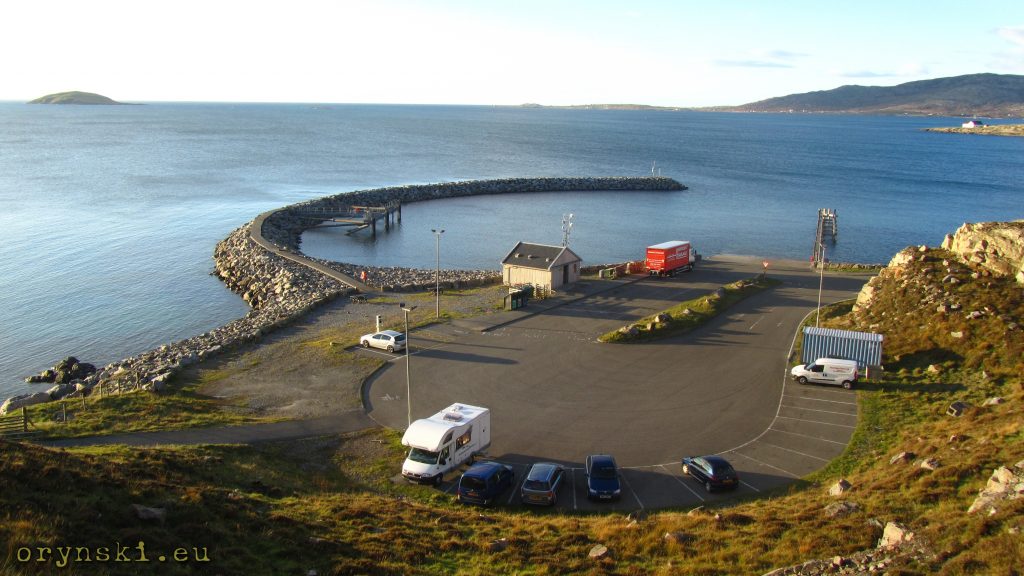
Meanwhile we arrive at Eriskay ferry terminal earlier than expected. There is just enough time to take a quick shower in the terminal building. Meanwhile from time to time, someone drives their car to the terminal and then leaves it with the keys in ignition. Obviously we are not the only ones who failed to secure space on the morning ferry, so people ship their cars ahead to join them on Barra in the morning as pedestrian passengers. Barratlantic driver does the same, leaving his Mitsubishi Canter open after taking his tachograph card out.
Seems that the only creatures to accompany us while we wait for the ferry will be two seals frolicing in the bay and some otters.
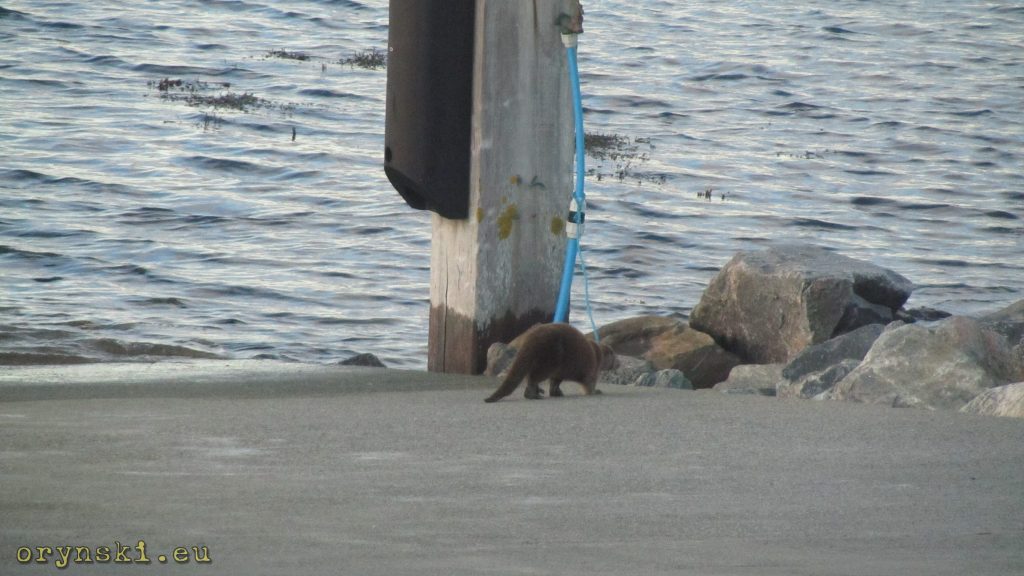
Finally the ferry arrives. This time it’s a smaller vessel, so called Loch Class. It’s design is similar to Bielik ferries that connect Świnoujście with the rest of Poland – one therethrough open deck with passenger cabin to the right on the side and on the bridge above with the wheelhouse located at the top of it. This time there was need to sort out any tickets, as due to the cancellation of our original route, this crossing was free of charge.
It took a while to load all vehicles abandoned at the terminal, but finally we are ready to go out to the sea. The crossing takes 40 minutes during which we can observe a sun setting over the horizon, so when we finally land on Barra, it is getting dark already. And because on that island there is in fact only one significant settlement – Castlebay – if we want to get some hot meal, we have to quickly drive, as it is located at the opposite end of the island. Luckily Barra, inhabited by approx 1000 people, is a small island – it’s main landmass is roughly of the shape of the 7 km wide circle and the circular A888 is the only significant road. In other words – on Barra, all roads go to Castlebay, and as you can see on this movie, you can drive a lorry to it’s opposite end in less than 20 minutes.
The hotel restaurant seems to be the only place offering a hot meal at this time. It was not the cheapest one, but everyone deserves a bit of luxury from time to time. Especially, that the dinner was really good, the view towards the castle in the bay (the name Castlebay is not taken out of nowhere) – beautiful, and since we were parked 20 m from the ferry terminal anyway and the crossing next morning was to take over 5 hours, we could allow ourselves a small pint.
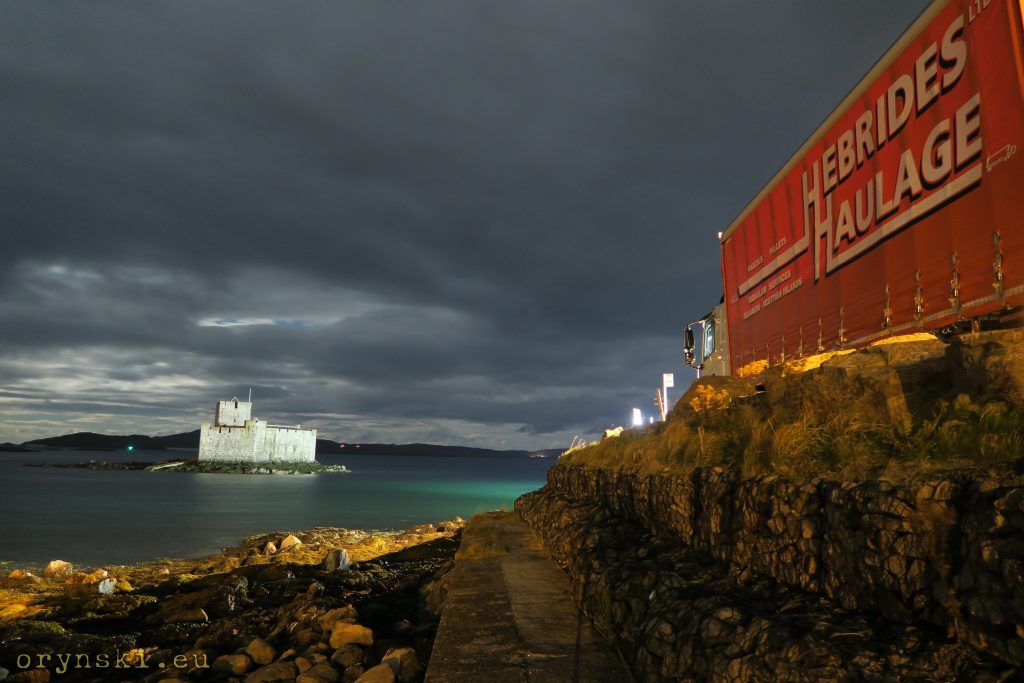
After dinner, we managed to take a few pictures using a tripod, but soon we faced difficulted to keep it stable. And it was not because we had too much of that beer – it simply started to get a bid windy. And when weather changes on Hebrides, it changes dramatically!
Below: map of the route covered on the second day of our journey
Back to the dull everyday life
Night storm is rocking the lorry so much, that one can feel like a baby in the cradle or dream about rollercoaster rides. The wind settles down in the morning, but the warm autumny sun is no more: piercing cold and freezing drizzle makes staying on the outside deck a true challenge. Last glance on the castle behind our stern, and time for a breakfast in the ferry’s cafe. While munching on our eggs, bacon and beans, we look out for dolphins that like to frolic in the wake.
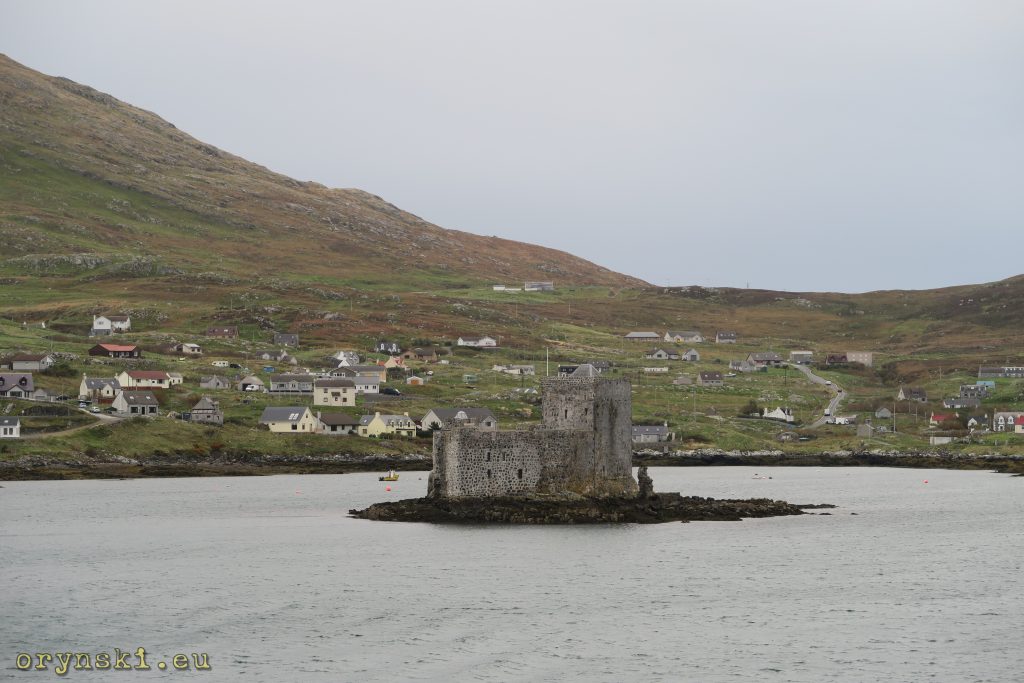
After two hours, the ferry enters Sound of Mull, separating the island from Ardnamurchan penninsula. This streat is like a busy street, as this is the main shipping route to Oban, the gate to Hebrides and major (for the scottish standards) port and transport hub. Apart from merchant and navy ships, we pass ferry to Coll and Tirre and cross the paths of ferries connecting Tobermory with Kilchoan and Lochaline with Fishinish. Closer to Oban we also pass vessels heading for Craignure and Lismore island. The lighthouse of the same name, proudly rising from the tiny rock at the bottom end of the island, signals, that we are about to enter the last stretch of open waters on our journey: Firth of Lorne. From here it is less than 30 minutes to our destination, but the Oban itself is hidden behind the Kerrera island, so the panorama of the city opens just before drivers are called to get down to their vehicles. On the approach to Oban the sun finally manages to peak through the layer of clouds, giving us an opportunity to snap a few stunning pictures.
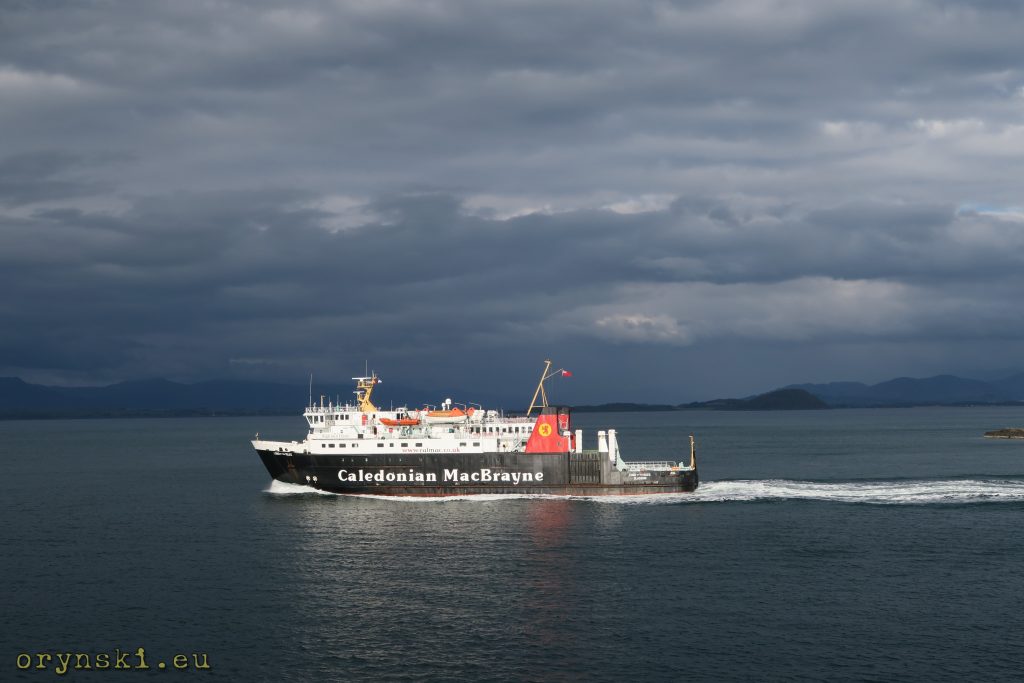
After visiting Barra, where that not-so-big fery was a size of the half of the “town”, disembarking in Oban is a true shock. Especially that the port is located in the city centre and the mountains towering over the bay force all traffic to use the main city’s road along the seaside. As a result, Oban city centre gets momentally gridlocked after vehicles disembark the ferry.
But do not worry – it’s not the end yet. It’s still about 3 hours drive to Glasgow – initially along Loch Etive, then along the river awe and a lake of the same name, then through the valleys of Loch Orchy and Loch Lochy to Tyndrum, where we close the loop opened two days earlier and return to Glasgow alond Loch Lomond on the road we already know. But after being to amazing Outer Hebrides, the views along that route suddenly seem so ordinary…
Below: map of the route covered on the third day of our journey.
* * *
Our three day journey ends here: we had a chance to see one of the most beautiful corners of this planet from behind the wheel of the truck. We visited places so remote, that very few tourist manages to reach, not to mention truckers. And if we consider, that of those three days, first was limited to a pleasure drive along the road commonly considered to be one of the most beaufitul in Scotland, and most of the third one we spent in a cosy armchair sipping hot chocolate and enjoying the views from the ferry, then even despite that middle day, in which we delivered a few palet and about a dozen of boxes, can it really be called working?
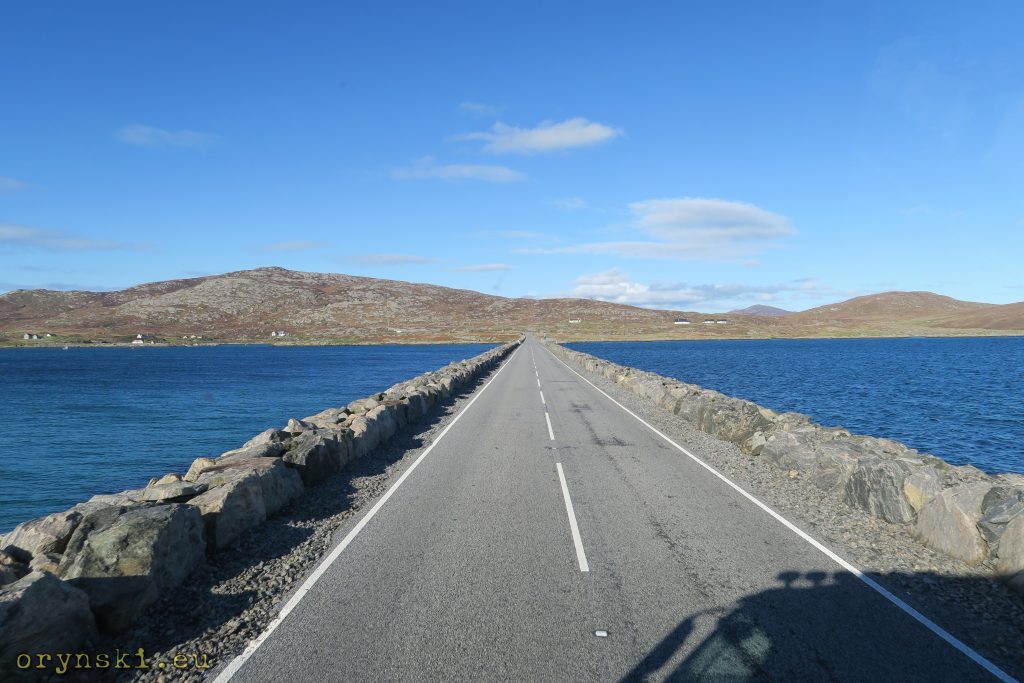
This reportage was originally published in Polish at 40ton.net

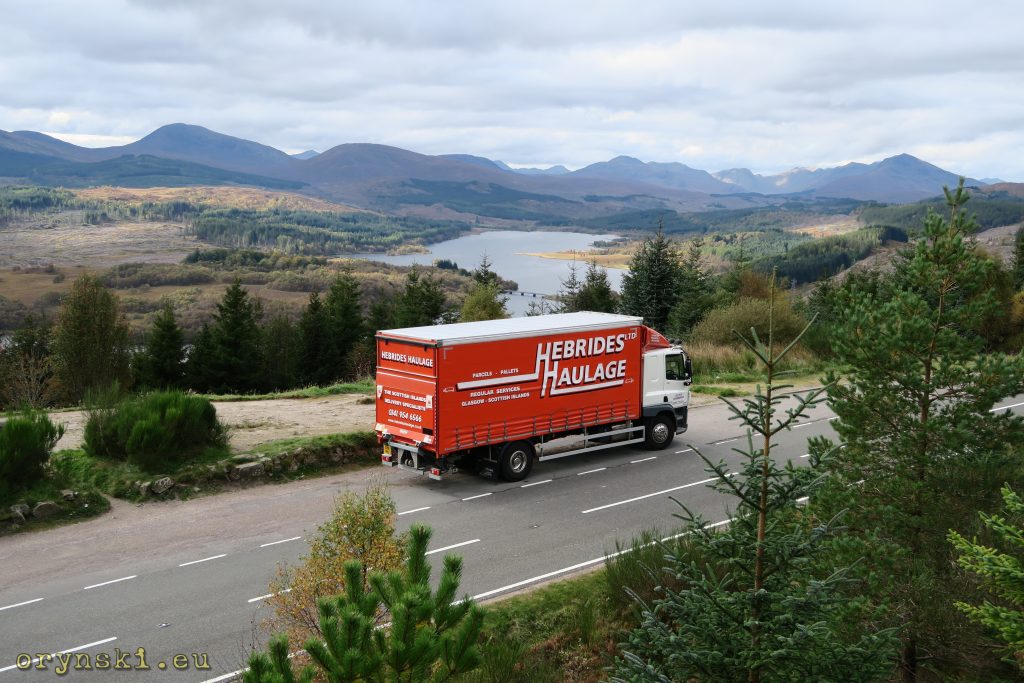
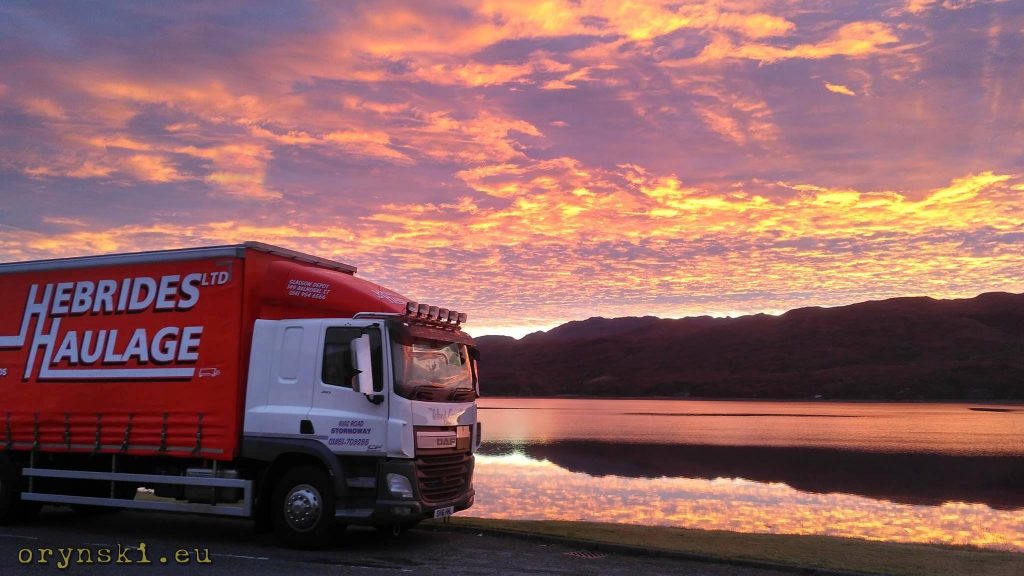

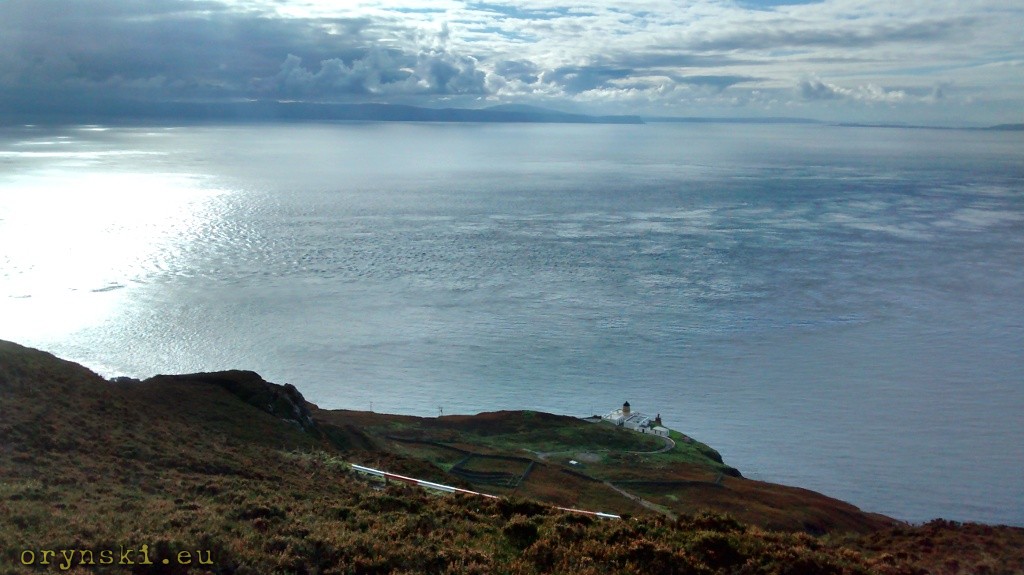
[…] Things are good. Ahead of us there is a wide beach, and it seems water is at low tide. And because, unlike the land, sand tend to be hard enough to support even heavy vehicles (on Barra the beach even doubles as an airport runway!), we can drive on it without any fears. Therefore we use the beach to make a wide u-turn, and since it would be a shame to pay only a night visit to the location, that can be so beautiful during the day, we decide to stay here for the night. Our lorry is safely parked as close to the tarmac as possible (as we don’t know how high water comes during high tide) and we go to the bed, hoping that the morning will welcome us with breathtaking view. And it did – but this part of the story is for another time. […]